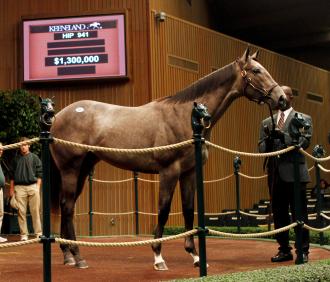
As you know horse racing partnerships add value. They find horses, risk the purchase price and syndicate to 5% and 10% partners. In order to do so, they need to charge a premium for the value added services – otherwise known as a markup.
If you think about it, breeders are eerily similar. They risk money to bring horses to market and expect a fair return. Breeders and Syndicators almost do almost the exact same thing. They both sell horses for more than they paid.
Most horse racing partnerships purchase their horses from breeders at major auctions like the recently concluded Keeneland sale in Lexington, KY. The Keeneland sale is the mecca of all sales. The jockey club estimates that 20,300 foals were born in 2014, with over 4,000 yearlings listed for sale at Keeneland in 2015.
The issue is the perception that this sale creates “the market”. In other words, when the hammer falls on a horse at $100,000 it is common to refer to the price as “what the market would bear”. You can see why. The biggest sale attracts the biggest buyers, and the horses go through a live auction. So, naturally one would think if the hammer fell at $100,000 then hundreds of owners weighed the horse carefully, many probably bid on the horse and eventually “the market dictated the price at $100,000”.
This is factually wrong.
Did you know it is absolutely legal for sellers to bid up their own horse (known as a live reserve) or for auctioneers to artificially bid up a horse (known as a set reserve)?
This means if the seller has a $99,000 reserve, the “live money” you hear at the auction (eg $25,000…now $50,000…now $75,0000) may simply be the auctioneer bidding up the horse to $95,000. If one real buyer bids $100,000 and the hammer falls, is that “the market price of the horse”? In my eyes, one, and only one, person in the whole world thought the horse was worth $100,000. All the other buyers at the sale combined didn’t make a bid.
Another example that I see is when a bloodstock agent makes a deal with the seller to buy a horse BEFORE THE HORSE ENTERS THE RING for $100,000. And then the bloodstock agent bids $150,000 at the auction. His client pays Keeneland $150,000 and the seller kicks back the bloodstock agent $50,000. Happens all the time.
Keeneland actually writes in their conditions of sale “Sales results reported by Keeneland may or may not reflect the fair market value of any horse(s) going through Keeneland’s sale…”
Why this means so much for horse racing partnerships goes back to that word – markup. A common question we get is “why do you get to markup a horse $50,000 one day after the horse was sold at auction for $100,000.” Ha!
My answer is always how do you know the market value of the horse? Why isn’t it $150,000? Horse racing partnerships like Little Red Feather Racing and West Point Thoroughbreds add tremendous value for that increase. LRF also pledges an honest, and transparent transaction. No back room deals or kick backs.
It’s time to rethink the auction approach and educate the public on hammer prices and what an actual market price is and isn’t. We recommend two changes to live auctions. Sellers can set a reserve but live money only can bid. If the hammer falls below, then list the RNA price and the final live money price. This transparency creates a true market value and is a reason why you should buy horses from reputable sources, like the best horse racing partnerships.
{{cta(‘7f90c40d-053f-4143-b319-a06be60edf5d’)}}
